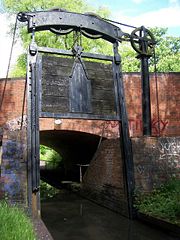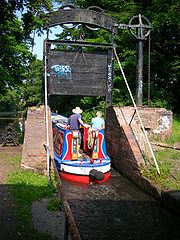
King's Norton Stop Lock
Encyclopedia


Kings Norton Junction
Kings Norton Junction is the name of the canal junction where the Stratford-upon-Avon Canal terminates and meets the Worcester and Birmingham Canal at Kings Norton, Birmingham, England....
on the Stratford-upon-Avon Canal
Stratford-upon-Avon Canal
The Stratford-upon-Avon Canal is a canal in the south Midlands of England.The canal, which was built between 1793 and 1816, runs for in total, and consists of two sections. The dividing line is at Kingswood Junction, which gives access to the Grand Union Canal...
near its junction with the Worcester and Birmingham Canal
Worcester and Birmingham Canal
The Worcester and Birmingham Canal is a canal linking Birmingham and Worcester in England. It starts in Worcester, as an 'offshoot' of the River Severn and ends in Gas Street Basin in Birmingham. It is long....
. It is the only guillotine-gated
Guillotine lock
A guillotine lock is a type of canal lock. The lock itself operates on the same principle as any normal pound lock, but is unusual in that each gate is a single piece, usually of steel, that slides vertically upwards when opened to allow a boat to traverse underneath...
stop-lock on a canal.
Description
This stop lock was built to prevent water flowing from one canal to another, regardless of which side was higher, but normally the Stratford-upon-Avon Canal was six inches higher. Canal companies were always concerned with the conservation of their own water supplies. There was also a toll house adjacent to the lock.The wooden guillotine style gates are suspended in a slightly raked cast iron girder frame by a chain which passes through a small block on the gate. One end of the chain passes over two large wheels to a winch mechanism. The other end passes over two more large wheels to a hidden counterweight built into the side wall of the lock. There was no need for paddle gear to fill or empty the lock. With such a small difference in water level a guillotine gate could easily be lifted to let water flow in and out.
The existing gates probably date from 19th century. Since the nationalisation of the canals in 1948, water loss from one canal to another is less of an issue, so the gates are no longer in use and are both left open. The last recorded use of the gates was 1959.
A bridge carries Lifford Lane over the lock, and hence the latter is sometimes referred to as Lifford Lane Stop Lock.
See also
- Canals of the United KingdomCanals of the United KingdomThe canals of the United Kingdom are a major part of the network of inland waterways in the United Kingdom. They have a colourful history, from use for irrigation and transport, through becoming the focus of the Industrial Revolution, to today's role for recreational boating...
- History of the British canal systemHistory of the British canal systemThe British canal system of water transport played a vital role in the United Kingdom's Industrial Revolution at a time when roads were only just emerging from the medieval mud and long trains of pack horses were the only means of "mass" transit by road of raw materials and finished products The...

